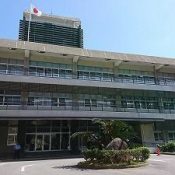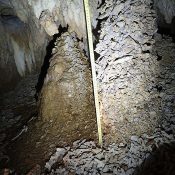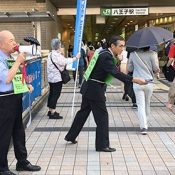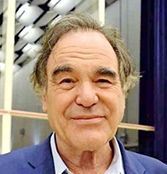Top News

September 17, 2018 Ryukyu Shimpo
Okinawa-born singer Namie Amuro, 40, retired on September 16. In the mid-90’s, Amuro sparked the fashion phenomenon known as “Amura” on the streets of Japan, and after marrying and having a child at age 20, continued to captivate the country as she continued to sing and dance while going through a divorce and raising a child.
Called the “Heisei Diva,” she broke records throughout Asia.
In her hometown Okinawa, where Amuro chose to end her music career, fans from both inside and outside of Japan for various events surrounding her retirement.
Late in the evening of the 16th, Amuro posted to her official homepage, “Even though these 25 years have passed by in an instant, I am happy to have been able to get close to my fans as a singer.
Thank you for the past 25 years.”
On September 15, Amuro had her final live show at the Okinawa Convention Center in Ginowan, where she performed eight songs in total.
On September 16, 30,000 fans gathered at Tropical Beach in the same city to send off Amuro with a fireworks show.
Amuro announced her retirement on her 40th birthday last year on September 20. Her greatest hits album, which she released last year, sold 2.3 million copies, making her the only singer to sell at least one million albums in each decade from her teens into her forties.
Her last dome tour attracted 750,000 people, which set a new record.
The tour DVD and Blu-ray sold over 1.57 million copies, making it the first-ever Japanese music movie to sell more than one million copies.
Amuro also won back to back Japan Record Awards in 1996 and 1997.
She was awarded the Okinawa Prefectural People’s Honor Award in May of this year.
The final show on September 15 prohibited press photography, however Amuro released photographs from the show on the evening of the 16th.
(English translation by T&CT and Sam Grieb)
Go to Japanese

September 20, 2018 Ryukyu Shimpo Digital Edition
In the case of the 20-year-old woman who was killed in April of 2016 while out walking in the central part of the main island, ex-Marine and U.S. base worker Kenneth Franklink Shinzato (34, formerly Gadson), who was convicted of rape and murder among other crimes related to the incident, appeared for his appeal trial at Fukuoka High Court’s Naha Branch 2:00 p.m. September 20.
Presiding judge Masamichi Okubo recognized the defendant’s intent to kill and upheld the Naha District Court’s initial life sentence, dismissing the appeal.
Shinzato appeared in court to hear the ruling.
(English translation by T&CT and Sam Grieb)
Go to Japanese

September 6, 2018 Ryukyu Shimpo
Stones from Madama-michi Road, a stone-paved road constructed in the 1500s during Ryukyuan Kingdom era was excavated on the grounds of Shuri Castle in Kinjo town, Shuri in Naha city.
The stones were located nearby the Shurei Gate (Shurei no mon), close to where the Madama-michi Road started.
The width of the road is 3.5 meters, and it continues for 4 to 5 meters. The stones were found 50 centimeters deep under the soil.
Kaoru Murata, 30, a specialist at the Okinawa Prefectural Archaeological Center, commented, “We knew that the road was located around here, but we did not think it would appear in such a nice form.
The condition of the road is better than we expected.”
A part of the Madama-michi Road was found around Hanta-gawa River in Naha city in April, but this is the first time part of the road was found in Shuri Castle.
The road was found during an excavation survey for a road improvement project.
The original stone pavement Madama-michi Road stretched over eight kilometers from Shurei Gate through Kinjo town in Shuri, Samukawa town, Hanta-gawa River, Onoyama, and Naha port.
The stones are made of Ryukyu limestone, and some parts have been scraped off. Each rock is of indefinite shape and is sized about 20 to 30 centimeters.
Ceramics from the 1500s were also excavated from the surrounding area, leading the excavators to determine the limestones to be Madama-michi Road.
Madama-michi Road was developed as a military road to prepare against pirates when they were a big threat during the King Shoshin era.
The road is planned to be covered under a protective sheet and be put back underground again later this month.
Although there is no event planned for showing the road, visitors can see the road through the fence around Shurei gate.
(English translation by T&CT and Sayaka Sakuma)
Go to Japanese

September 24, 2018 Ryukyu Shimpo
Shuri Castle Park held their “Mid-autumn Harvest Banquet” September 23 on a special stage in front of the main hall at Shuri Castle.
The “King and Queen Public Election Meeting” was also held (hosted by the Shuri Castle Festival Executive Committee), and University Staff Hiroyuki Kamiyama, 26, from Nago was selected as the new king, and company employee Iroha Nagamine, 25, from Okinawa City was selected as the new queen.
Kamiyama said, “I want to do my best since it is valuable to be able to experience the history and culture of the Ryukyu Kingdom from the viewpoint of the king.”
Nagamine said smiling, “I want to share the history of the Ryukyu Kingdom with the world. I think I will grow and learn in my role as queen.”
The new royals were selected from a group of 48 applicants. Starting with the Shuri Castle festival October 27, the two will serve at Shuri Castle Park events for one year.
During the “Manzai Tichiuchi” group dance, light rain began to fall and the banquet was paused for a brief time. After it started again the new king and queen were selected. The scheduled dances called “Nubuikuduchi” and “Karaya” were canceled.
(English translation by T&CT and Sam Grieb)
Go to Japanese

September 20, 2018 Ryukyu Shimpo
Experts who investigated the Nagashima caves located off Cape Henoko, Nago City found something they are tentatively calling a “consolidated stone tower.”
These studies found that calcareous sediment congealed to form a beachrock stalagmite in this coastal limestone cavern, which grew as bits of coral adhered to it.
Experts evaluated that: “This appears to be the only such specimen in the country and it is extremely rare. It has very high value academically.”
They pointed out the need for more scientific investigations.
On September 19, the Nature Conservation Society of Japan (NACS-J) held a press conference at the Prefectural Office and announced this discovery.
Chihiro Tsujimura of NACS-J pointed out, “It may be valuable data for understanding the process of island formation in Okinawa geologically and topographically.”
She requested to designate it as a natural monument, and asked for the prefectural government to take the lead in conducting thorough research.
Nagashima is located near the temporarily restricted area of Henoko where construction of the new base is being carried out, and entry is prohibited.
However, due to the withdrawal of land reclamation approval by the prefectural government and construction being canceled, NACS-J conducted an urgent study in the cave on September 8 and September 12.
This study was conducted with the cooperation of lecturer of coral reef geography and topography Tatsuro Nakai from Kokushikan University and Associate Professor of marine biology Yoshihisa Fujita from Okinawa Prefectural University of Arts.
NACS-J’s Mariko Abe said that if the ocean current and tidal current change due to land reclamation work, it will cause immeasurable effects on the stone tower.
“The natural environment is precious for many reasons including academia and we must preserve it,” she said.
On the same day, NACS-J officials explained the survey results and submitted a request to Deputy Governor Kiichiro Jahana, asking for studies of the caves in Nagashima.
(English translation by T&CT and Megumi Chibana)
Go to Japanese

September 24, 2018 Ryukyu Shimpo
On September 23, there were simultaneous actions throughout Japan as part of a movement calling for U.S. military bases to be withdrawn from Okinawa.
Members of the Okinawa Base Withdrawal Association’s Tokyo Network gathered in front of Hachioji Station in Tokyo, distributing pamphlets bearing the words: “We can no longer feign ignorance.”
Association members called out slogans like, “Isn’t it our responsibility to equally share the base burden?”
Up to this point the Association’s Tokyo Network has been putting efforts into activism in central Tokyo.
On September 23, it chose to act in front of Hachioji Station in the hope this would encourage participation from Hachioji City.
Makoto Ijima, an official of the Tokyo Network, took a handheld microphone and spoke at the gathering. He said that while public approval of the U.S.-Japan security structure is at 80 percent, the U.S. military insists Okinawa should accept and bear the risks associated with its large share of the base burden because the U.S. is providing Japan with defense.
However, Ijima asserted that, “These circumstances cannot simply be left as they are now.”
Also on September 23, there were similar public demonstrations in Yamagata, Niigata, and Fukuoka calling for U.S. base withdrawal from Okinawa.
An organization in Osaka planned its own demonstration for September 24.
(English translation by T&CT and Erin Jones)
Go to Japanese

September 5, 2018 Ryukyu Shimpo
A commercial facility called Okinawa Plaza opened in Waipahu, Hawaii, as a new base for Okinawa-related acctivities.
The opening ceremony was held on September 3.
The plaza is located next to the Hawaii Okinawa Center, which is managed by the Hawaii United Okinawa Association.
The goal of the plaza is to use rent from the business operators in the plaza to maintain the center as well as to support Okinawa-related activities. Six hundred people, including the third-generation Okinawan-American governor of Hawaii, David Ige, attended the ceremony to celebrate the opening of the facility.
Courtney Takara, president of the Hawaii United Okinawa Association, ensured that, “We will continue our effort to keep strong ties with Okinawa as well as to pass down our traditional culture to the next generation.
We will do so while keeping our first-generation Okinawans’ effort in mind.” Governor Ige said, “The creation of the plaza strengthened the connection between Hawaii and Okinawa.”
He spoke further about the governor of Okinawa, Takeshi Onaga, who passed away recently, saying “[The governor] devoted his life to strengthen our bond. He was a symbol of goodness of Okinawa.”
(English translation by T&CT and Sayaka Sakuma)
Go to Japanese

September 4, 2018 Ryukyu Shimpo
On August 29, the Okinawa Prefectural Government (OPG), Keelung Port of Taiwan, and the Jeju Special Self-Government Province of South Korea concluded a memorandum regarding cruise promotions. The three parties will cooperate to take part in activities to promote and attract cruise line companies. A ceremony was held on Jeju Island, South Korea.
The memorandum included: increasing the number of stops at ports by proactively accepting the cruise ships from each other’s port, cooperating with one another’s tourist promotions, exchanging cruise-related information, and participating in events like business meetings. Many cruise ships arrive at Okinawa from Keelung, so both parties will continue to deepen their partnership. Jeju Island, which does not have a direct route to/from Okinawa, aims to create new cruise routes.
Head of OPG’s Department of Culture, Tourism, and Sports Takao Kadekaru said, “We will maximize the effects of the memorandum’s agreements. We will work with Keelung Port and Jeju Special Self-Government Province in hopes of attracting cruise companies and cruise ships from around the world.”
The “East Caribbean Plan,” which was drawn up this past March, includes deepening the partnership related to domestic/international ports, local government, and promoting tourism.
(English translation by T&CT and Chelsea Ashimine)
Go to Japanese
September 8, 2018 Ryukyu Shimpo
The group for consideration of the Futenma/Henoko problem (represented by Osaka City University Professor Emeritus Kenichi Miyamoto) comprised of various experts in Japan released a joint statement at a press conference at the Diet September 7 requesting things such as the retraction of the plan for new base construction at Henoko in Nago City. AS of September 7, 72 people had attached their name to the statement.
Among the people endorsing the statement were authors Jiro Akagawa and Hisae Sawachi, but also included experts in a variety of fields such as marine biology and ornithology.
This is the fourth statement released by the group. They have also called for the cancellation of base construction at Henoko, and have expressed their support for the resolution passed at a protest event in Okinawa August 11, as well as Okinawa Prefecture’s decisions to revoke permission for land reclamation work in Henoko Bay.
At the press conference, Professor Miyamoto commented, “The Henoko problem is a Japanese problem, so it is all of our problem.
Particularly, it is a duty the people of mainland Japan cannot fail to fulfill.” Alongside Dr. Miyamoto was Tokyo Keizai University Associate Professor Nami Okubo, a coral expert, noted that the environmental destruction resulting from the construction at Henoko is in violation of the United Nation’s sustainable development goals.
The joint statement has as of September 7 been officially endorsed by 37 people.
The group plans to call for more endorsers on their website, after which they will submit the statement to the Abe cabinet.
Also on September 7, a similar statement was released by the “No War! Don’t Repeal Article 9! Comprehensive Executive Committee.”
(English translation by T&CT and Sam Grieb)
Go to Japanese
September 13, 2018 Ryukyu Shimpo
The candidates for the 13th Okinawa gubernatorial election were announced September 13.
The election is happening ahead of schedule due to the untimely death of Governor Takeshi Onaga, who died while in office.
So far, four candidates announced their candidacies, but Ginowan Mayor Atsushi Sakima, 54, who is running as an Independent but has the support of the Liberal Democratic Party (LDP), Komeito, the Japan Innovation party (JIP), and Congressman Denny Tamaki, 58, also running as an Independent with the support of the coalition in control of the Okinawan government, are the clear front-runners.
Both candidates have acknowledged that despite the number of announced candidacies that the election is a head-to-head matchup. The election is set to take place September 30.
While the biggest issue of the election continues to be whether or not to allow new base construction at Henoko in Nago City, the issues that the two candidates will verbally spar over include how to return the land currently occupied by MCAS Futenma, economic stimulation, child poverty, child-raising support, healthcare, and social welfare.
It is almost universally agreed that the result of this election will have a major impact on the future of the new base construction in Henoko.
At his candidacy announcement rally at Itomine-kaikan in Makishi, Naha, Sakima said, “The day-to-day lives of Okinawans is important. Antagonism and divisiveness will lead to nothing.
Through negotiation [with the central Japanese government] I say the thoughts of Okinawans. I will work to lead Okinawa with harmony in mind.”
Tamaki said at his rally, held in the Tacchu parking lot for Mt. Gusuku in Ie said, “I will continue Governor Onaga’s legacy and prevent the new base at Henoko from being built.
I will make his dying wish clear and fight in this election with all my might.” The other two candidates to announce were Ryukyu cuisine researcher Hatsumi Toguchi, 83, and former IT company employee Shun Kaneshima, 40, both running as independents.
(English translation by T&CT and Sam Grieb)
Go to Japanese

September 8, 2018 Ryukyu Shimpo online edition
On September 7, 133 scholars and informed persons from around the world including the US, Canada and Australia signed and issued a statement in support of the Okinawa Prefectural Government’s revocation of the land reclamation approval for the Futenma replacement facility being constructed in Henoko, Nago City, originally given by former Governor Hirokazu Nakaima.
The statement points out that, “Base construction flies in the face of constitutional principles such as popular sovereignty and the right to regional self-government.”
It calls on US President Donald Trump and Japanese Prime Minister Shinzo Abe to promptly halt construction of the Henoko base, and to demilitarize Okinawa.
This is the 4th international statement made by informed persons from around the world in relation to construction in Henoko.
The international statement was signed starting with linguist Noam Chomsky and Academy Award winning director Oliver Stone, followed by other scholars and cultured persons from around the world including Pulitzer Prize winner John Dower and Nobel Peace Prize laureate Mairead Maguire.

Oliver Stone
In January 2014 Chomsky and others released a prior statement opposing the Futenma replacement facility and requesting the immediate and unconditional return of Futenma Air Station’s land to Okinawa.
Even following the 2014 international statement the US and Japanese governments ignored Okinawans’ popular will and continued forcing through construction of the replacement facility including setting dates to deposit soil in the ocean.
Those signed on to the statement saw that the circumstances were not getting any better but rather getting even worse, so they decided to raise their voices again.
In addition to addressing the replacement facility being built in Henoko, the newest statement has also raised the issue of SDF deployment to the Nansei Islands such as Miyako Island, Ishigaki Island, and Amami Oshima.
It pointed out that, “It is time to rethink the ‘fortress’ role assigned to Okinawa by successive Japanese governments and U.S. military and strategic planners and to begin to articulate a role for Okinawa, including its ‘frontier’ islands, as the centre of a de-militarized community to be built around the East China Sea.”

John Dower
Furthermore, this new statement asserts, “Okinawan opposition to the construction of a new base has been constant, reaching at times over 80 per cent in public opinion surveys, and has been repeatedly affirmed in elections.”
Those who signed the statement are also encouraging the candidates up for election for the Governorship of Okinawa on September 30 to make clear their intent to carry out the manifest will of the Okinawan people to close Futenma Air Station and stop
construction in Henoko.
(English translation by T&CT and Erin Jones)
Go to Japanese











 Webcam(Kokusai Street)
Webcam(Kokusai Street)


